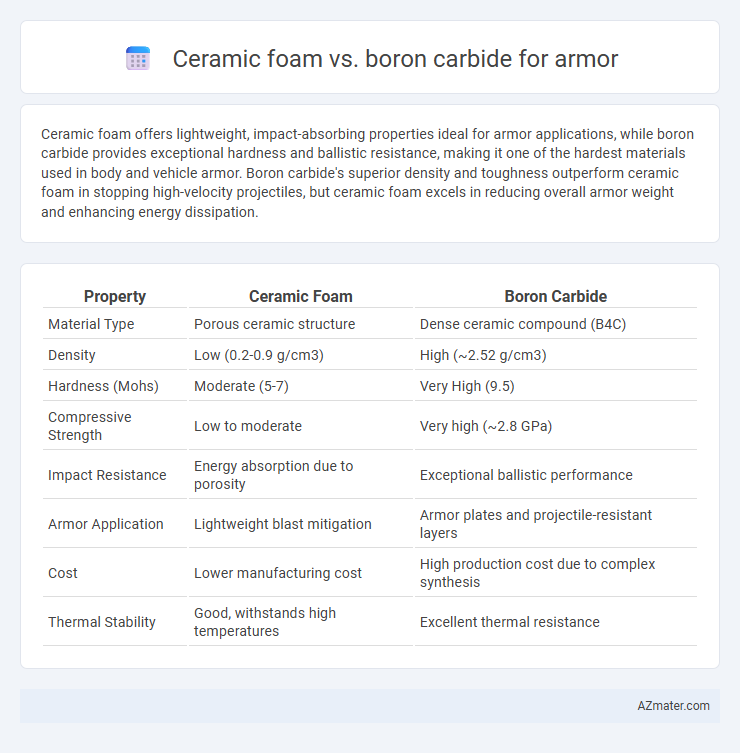Ceramic foam offers lightweight, impact-absorbing properties ideal for armor applications, while boron carbide provides exceptional hardness and ballistic resistance, making it one of the hardest materials used in body and vehicle armor. Boron carbide's superior density and toughness outperform ceramic foam in stopping high-velocity projectiles, but ceramic foam excels in reducing overall armor weight and enhancing energy dissipation.
Table of Comparison
| Property | Ceramic Foam | Boron Carbide |
|---|---|---|
| Material Type | Porous ceramic structure | Dense ceramic compound (B4C) |
| Density | Low (0.2-0.9 g/cm3) | High (~2.52 g/cm3) |
| Hardness (Mohs) | Moderate (5-7) | Very High (9.5) |
| Compressive Strength | Low to moderate | Very high (~2.8 GPa) |
| Impact Resistance | Energy absorption due to porosity | Exceptional ballistic performance |
| Armor Application | Lightweight blast mitigation | Armor plates and projectile-resistant layers |
| Cost | Lower manufacturing cost | High production cost due to complex synthesis |
| Thermal Stability | Good, withstands high temperatures | Excellent thermal resistance |
Overview of Ceramic Foam and Boron Carbide in Armor Applications
Ceramic foam and boron carbide are critical materials in armor protection, each offering unique benefits due to their distinct microstructures and hardness. Ceramic foam provides enhanced energy absorption and weight reduction through its porous structure, making it effective in dissipating ballistic impact forces. Boron carbide is among the hardest materials used in armor, delivering exceptional penetration resistance and lightweight durability, which is crucial for personal and vehicle armor systems.
Material Composition and Structure Comparison
Ceramic foam armor primarily consists of porous alumina or silicon carbide, providing lightweight impact absorption through a cellular structure that dissipates energy via deformation and fracture. Boron carbide armor is composed of dense, crystalline boron carbide particles with high hardness and abrasion resistance, delivering superior ballistic protection by shattering incoming projectiles. The porous matrix of ceramic foam offers enhanced energy dispersion but lower hardness, while boron carbide's compact, dense microstructure maximizes penetration resistance and structural integrity.
Mechanical Strength and Durability
Ceramic foam offers excellent impact absorption and lightweight properties but generally has lower mechanical strength compared to boron carbide, which ranks among the hardest and most durable materials used in armor applications. Boron carbide exhibits exceptional hardness (approximately 29 GPa on the Mohs scale) and high wear resistance, making it superior for withstanding ballistic impacts and prolonged mechanical stress. The porous structure of ceramic foam improves energy dissipation yet sacrifices some durability and resistance to fracture compared to the dense, ultra-hard boron carbide plates.
Ballistic Performance Analysis
Ceramic foam armor offers superior energy absorption and fragmentation control due to its high porosity and lightweight structure, enhancing multi-hit ballistic performance. Boron carbide, recognized for its extreme hardness and high compressive strength, excels in defeating armor-piercing projectiles with reduced armor thickness and weight. Comparative ballistic analysis reveals boron carbide delivers higher resistance to penetration, while ceramic foam provides improved shock wave dispersion, making them complementary choices in advanced armor systems.
Weight and Density Considerations
Ceramic foam armor offers significantly lower density compared to boron carbide, resulting in lighter protective materials advantageous for mobility and comfort. Boron carbide, with a density around 2.52 g/cm3, provides superior hardness and ballistic resistance but adds more weight to armor systems. Weight-sensitive applications often prefer ceramic foam due to its porous structure, which reduces mass while retaining impact absorption capabilities, although it may sacrifice some hardness relative to boron carbide.
Cost Efficiency and Availability
Ceramic foam offers a cost-efficient solution for armor applications due to its lower raw material and manufacturing expenses compared to boron carbide, which is among the most expensive and hardest materials used in armor. Availability of ceramic foam is higher, with widespread production and easier scalability, whereas boron carbide faces limitations from complex synthesis processes and constrained supply chains. Choosing ceramic foam can reduce overall armor system costs while maintaining effective ballistic protection, especially in large-scale or budget-sensitive defense projects.
Manufacturing and Fabrication Processes
Ceramic foam armor utilizes a manufacturing process involving high-temperature sintering of ceramic powders combined with pore-forming agents, resulting in a lightweight, porous structure that enhances energy absorption and reduces overall armor weight. Boron carbide fabrication employs hot pressing or spark plasma sintering to produce dense, hard ceramic tiles, offering exceptional ballistic resistance but requiring precise temperature control and pressure to avoid grain growth and maintain mechanical strength. The porous nature of ceramic foam simplifies integration with composite backing materials, whereas boron carbide's dense, brittle form demands advanced machining and bonding techniques to prevent cracking during assembly.
Thermal and Chemical Resistance
Ceramic foam exhibits excellent thermal resistance, withstanding temperatures above 1600degC while providing lightweight insulation, whereas boron carbide offers superior chemical inertness and thermal stability up to approximately 2200degC. Boron carbide's remarkable hardness and corrosion resistance make it highly effective against chemical attack in harsh environments, surpassing ceramic foams in durability under extreme conditions. Thermal shock resistance is higher in boron carbide, making it preferable for armor systems requiring rapid temperature fluctuations and chemical resistance.
Versatility in Military and Civilian Armor
Ceramic foam offers exceptional energy absorption and lightweight properties, making it versatile for both military vehicle armor and civilian protective gear, such as riot shields and structural reinforcements. Boron carbide provides superior hardness and ballistic resistance, widely preferred in personal body armor and armored vehicle plating, ensuring high durability in extreme combat scenarios. The combination of ceramic foam's shock absorption and boron carbide's hardness facilitates adaptable armor solutions tailored for diverse military and civilian defense applications.
Future Trends and Innovations in Armor Materials
Ceramic foam and boron carbide remain at the forefront of armor material innovation due to their exceptional hardness and lightweight properties. Emerging trends emphasize enhancing ceramic foam's porosity for improved energy absorption while developing boron carbide composites with nanostructured reinforcements to increase fracture toughness. Future advancements are likely to integrate multifunctional coatings and hybrid layering techniques, optimizing ballistic resistance and thermal management in next-generation armor systems.

Infographic: Ceramic foam vs Boron carbide for Armor
 azmater.com
azmater.com